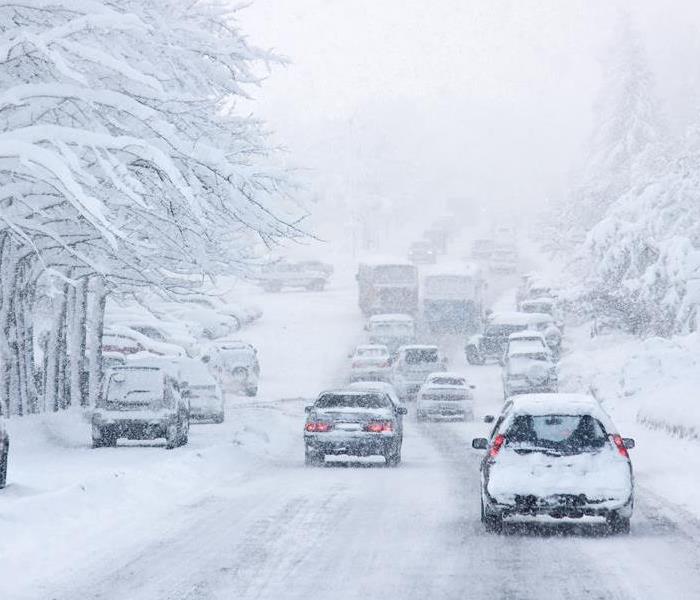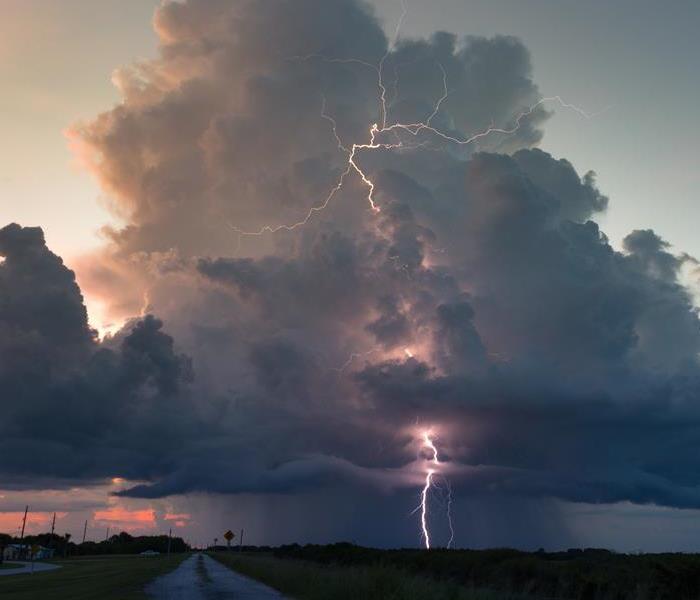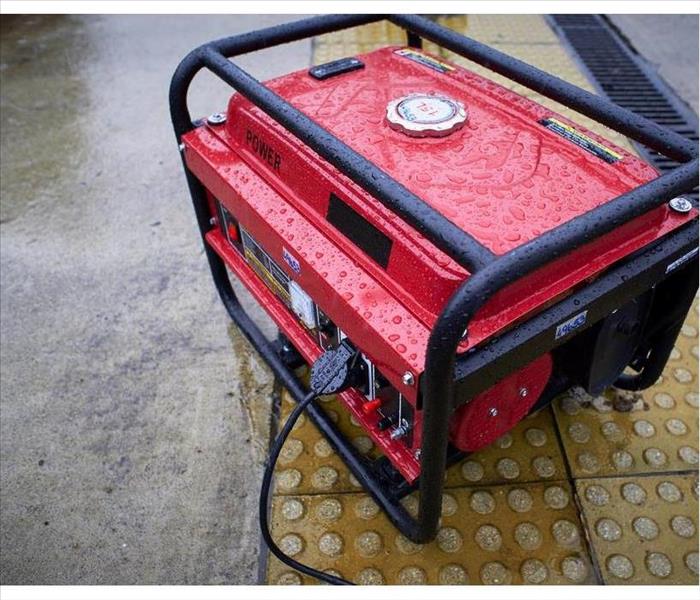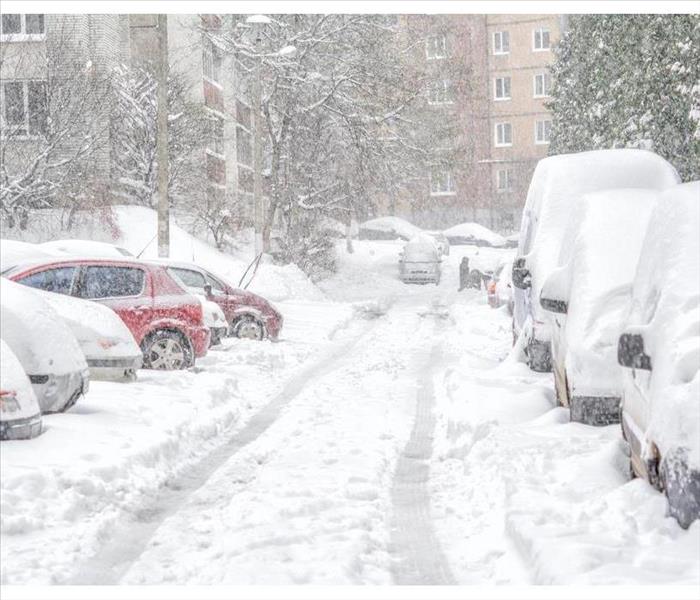Archived Storm Damage Blog Posts
Navigating the Storm: The Vital Role of Snow Removal Services
1/16/2024 (Permalink)
The Northeastern United States is no stranger to winter storms, where heavy snowfall blankets the landscape, transforming it into a picturesque winter wonderland. However, this beauty often comes with a challenging aftermath, necessitating swift and efficient snow removal services to restore normalcy. In this blog, we explore the crucial role these services play in the cleanup process following winter storms in the Northeast.
Mitigating Safety Risks
Excessive snow accumulation poses significant safety risks, from slippery sidewalks to blocked roadways. Snow removal services play a critical role in mitigating these risks by clearing pathways, driveways, and streets, ensuring safe and accessible routes for both pedestrians and vehicles.
Preventing Property Damage
The weight of accumulated snow can strain structures, causing damage to roofs, awnings, and other vulnerable areas. Professional snow removal services are equipped to prevent potential property damage by efficiently clearing snow from roofs and other critical structures, preserving their integrity.
Maintaining Business Continuity
For businesses in the Northeast, timely snow removal is essential for maintaining continuity during the winter season. Snow removal services help ensure that commercial properties, parking lots, and access points remain clear, allowing businesses to operate smoothly without disruptions.
Enhancing Emergency Response
In the event of a medical emergency or fire, quick and unimpeded access is paramount. Snow removal services play a crucial role in facilitating emergency response efforts by keeping roads and pathways clear, enabling first responders to reach their destinations swiftly.
Protecting Landscaping and Infrastructure
Snow and ice accumulation can be detrimental to landscaping features, walkways, and other outdoor infrastructure. Professional snow removal services use specialized equipment and techniques to clear snow without causing damage to these essential elements, preserving the aesthetic and functionality of outdoor spaces.
Complying with Local Regulations
Many municipalities in the Northeast have regulations in place requiring property owners to clear snow from sidewalks and driveways promptly. Snow removal services assist property owners in meeting these obligations, avoiding potential fines and contributing to the overall safety and accessibility of the community.
Minimizing Liability Risks
Accumulated snow and ice increase the risk of slips and falls, leading to potential liability issues for property owners. Snow removal services help minimize these risks by promptly and thoroughly clearing walkways and public spaces, reducing the likelihood of accidents and associated liabilities.
Improving Transportation Efficiency
Northeastern cities and towns heavily rely on efficient transportation systems. Snow removal services are instrumental in ensuring that roads, highways, and public transportation routes are kept clear, promoting smooth traffic flow and minimizing disruptions to daily commutes.
Alleviating Environmental Impact:
Beyond safety and infrastructure concerns, snow removal services also play a role in environmental stewardship. Professional services employ eco-friendly practices and materials, minimizing the environmental impact of snow removal efforts while effectively managing snow accumulation.
Enhancing Quality of Life
Ultimately, the role of snow removal services in Northeast storm cleanup extends beyond practical considerations. By swiftly and efficiently clearing snow, these services contribute to the overall quality of life for residents, allowing them to navigate their communities with ease and enjoy the winter season without undue challenges.
In conclusion, the services provided by professional snow removal companies are essential for managing the aftermath of winter storms in the Northeast. Their expertise not only ensures safety and accessibility but also contributes to the resilience and efficiency of communities grappling with the challenges of winter weather.
Preparing Your Business for Winter Storms: Lessons Learned
9/13/2023 (Permalink)
 Preparing for winter storm is essential to keep your business open and operating.
Preparing for winter storm is essential to keep your business open and operating.
Winter storms in the Northeast can be both beautiful and treacherous. While they bring picturesque snowy landscapes, they can also wreak havoc on businesses if not adequately prepared. As a business owner, it is essential to learn from past experiences and be well-prepared for the challenges that winter storms can present. In this blog post, we will explore important lessons learned and provide valuable tips for preparing your business for Northeast winter storms.
Develop a Comprehensive Emergency Plan
Having a well-developed emergency plan is crucial for any business, especially in areas prone to winter storms. Your emergency plan should include procedures for employee safety, communication protocols, protocols for securing your premises, and contingency plans for business operations during and after a storm. It is essential to regularly review, update, and communicate your emergency plan to all employees to ensure everyone knows what to do in the event of a winter storm.
Maintain and Inspect Your Building
Regular maintenance and inspection of your building can help identify and address vulnerabilities before a winter storm hits. Ensure that your roof is in good condition, and any potential leaks or areas of weakness are addressed promptly. Inspect windows and doors for proper sealing and insulation to prevent drafts and moisture infiltration. Additionally, check your heating system to ensure it is functioning properly, and have it serviced regularly to avoid unexpected breakdowns during a storm.
Stock Up on Essential Supplies
Stocking up on essential supplies well in advance of a winter storm can help ensure your business can continue to operate smoothly. This includes items like road salt, shovels, de-icing products, emergency lighting, first aid kits, and extra food and water supplies. Don't forget to inform employees about the location of these supplies and educate them on their usage.
Communicate and Train Employees
Communication is key during a winter storm. Ensure that employees are well-informed about the company's emergency plan, their specific roles and responsibilities, and how to stay connected with the organization during and after a storm. Consider conducting emergency response and safety training sessions to equip your employees with the knowledge and skills needed to respond appropriately during a winter storm.
Develop a Remote Work Policy
Winter storms can disrupt transportation and make it challenging for employees to commute to work. Consider developing a remote work policy that allows employees to work from home during severe winter weather conditions. Ensure that employees have the necessary tools, such as laptops and access to remote collaboration software, to perform their work effectively from a remote setting.
Stay Informed and Monitor Weather Updates
As a business owner, it is crucial to stay informed about weather updates and monitor forecasts during the winter season. Sign up for weather alerts and notifications, and follow reputable weather sources for the latest information on storms. This will help you make informed decisions regarding business operations, employee safety, and customer communication.
Preparing your business for Northeast winter storms requires careful planning and proactive measures. By developing a comprehensive emergency plan, maintaining and inspecting your building, stocking up on essential supplies, communicating and training employees, developing a remote work policy, and staying informed about weather updates, you can minimize the impact of winter storms on your business. Remember, being prepared is not just about protecting your property, but also the safety and well-being of your employees and customers. By applying these lessons learned, you can ensure that your business is resilient, adaptable, and ready to tackle whatever winter storms the Northeast may bring.
When the Lights Go Out: Your Options for Dealing with a Power Outage After a Storm
6/8/2023 (Permalink)
 Power outages could occur after a storm or severe weather event.
Power outages could occur after a storm or severe weather event.
Power outages are a common occurrence after a storm or severe weather event. These outages can last for several hours or even days, leaving you without access to essential resources such as light, heat, and food. Knowing your options during a power outage can help you stay safe and comfortable until the power is restored.
Here are some of the options you have if the power goes out after a storm:
Use a generator
A generator can provide you with electricity during a power outage. Generators come in various sizes and types, and can power anything from a single appliance to your entire home. However, it's important to follow safety precautions when using a generator, such as keeping it outside and away from open windows and doors.
Use a battery-powered backup
A battery-powered backup is an excellent option for powering small devices, such as cell phones, laptops, and flashlights. These backups can be recharged using a solar panel or a car charger, making them a convenient and sustainable option.
Use a gas-powered stove
If you have a gas-powered stove, you can still cook and prepare meals during a power outage. Just make sure to keep a window or door open for ventilation.
Use alternative lighting sources
Candles, oil lamps, and battery-powered lights can provide you with lighting during a power outage. Make sure to keep these sources away from flammable objects and never leave them unattended.
Stay warm
If it's cold outside, staying warm during a power outage is essential. Bundle up with warm clothing and blankets, and consider using a gas-powered heater or a wood-burning stove to stay warm.
Preserve food
If you have a refrigerator or freezer, try to keep the doors closed as much as possible during a power outage to help preserve food. If the outage is expected to last for more than a day, consider using a cooler with ice to keep perishable items cold.
Stay informed
Keep a battery-powered radio or portable charger on hand to stay informed about the latest news and updates on the power outage. This can help you make informed decisions about your safety and well-being.
In conclusion, power outages can be a frustrating and inconvenient experience, but knowing your options can help you stay safe and comfortable until the power is restored. Whether you use a generator, battery-powered backup, or alternative sources of lighting and heat, always prioritize safety and follow the manufacturer's instructions for proper use.
Getting Your House Ready for a Hurricane
1/10/2023 (Permalink)
 Install and maintain a generator
Install and maintain a generator
Preparing for Hurricanes
A hurricane can hit your home at any time, so you need to be prepared for it. Here are some things you should do before the storm hits:
Protect and Clear Gutters
Leaves and other debris can accumulate in your gutters, blocking the flow of water that's supposed to get rid of it. If this happens, you may end up with leaks around your house and even flooding on the ground floor. Remove any obstructions from your gutters so they can do their job properly! If you have a gutter guard installed, make sure it is secure so water doesn't get trapped behind it. Consider installing one if you don't already have one—it's an easy way to keep your gutter clean without having to climb up onto a ladder every time something falls into them!
You should also secure loose rain gutters or extensions with brackets. If you don't have enough brackets, you can use plastic zip ties to secure your rain gutters. Fasten brackets to the fascia board (the board that runs across the top of your exterior wall). Secure both ends of the gutter strap over each bracket's screw hole and then tighten down each screw.
Install Storm Shutters
The first step to protecting your home from hurricane-force winds is to install storm shutters on all windows. When shopping for storm shutters, you'll find that there are two kinds: permanent and removable. Permanent storm shutters are installed by professional contractors and should last for as long as your home does. They're made with strong materials like metal or plastic, which makes them more expensive but also more durable than their removable counterparts.
You can install removable storm shutters yourself if you have the time and energy (or money). This type of shutter usually attaches to the window frame with screws, but some come with adhesive strips or suction cups instead. If you choose this option, make sure that the instructions are clear; otherwise, it's easy to accidentally damage both windows and frames when installing your temporary protection against hurricanes!
Install a Generator
One of the most important things you can do to make sure your home is ready for a hurricane is to install and maintain a generator. A generator will keep your refrigerator and freezer running, as well as power lights and other appliances that are essential during an outage.
If you don't have a permanent generator installed at home or work yet, now is the time to look into getting one. Generators should be tested every month with fuel added as needed so they will start immediately when needed during an emergency situation or power outage.
Protect your Garage Door
Garage doors are particularly vulnerable to high winds because they're large, heavy, and often double-sliding. The best way to secure your garage door is to brace it against the frame, using a length of lumber at least 2 feet long and 1 inch thick. If you have a chain or rope available, tie it around the door track above the garage door’s top hinge so that it can't be lifted out of its tracks by strong winds blowing into the garage.
Sandbags are commonly used for flood protection, but they can also be used to protect your garage door. The sandbags should be placed on the exterior of your garage door so that if water comes in from a hurricane it will flow around the sandbags and not directly into your home. To do this, place several bags along the perimeter of your garage door so that they form a barrier between it and the house. The bags should be filled with either soil or sand (not concrete) and stacked two high, with no gap between them and the garage door.
Inspect your Roof
It's probably a good idea to inspect your roof before the storm arrives, so you know what to look for when it does.
Check for loose shingles or tiles. Loose shingles are easy to spot, but if you don't have time to climb up onto your roof and check for them, look for any signs of water damage on the outside of your house (e.g., brown spots that could indicate leaking from a bad roof).
Check for damage to the roof—especially around pipes and chimneys. If you see any signs of damage like cracks in flashing or missing shingles, call experts in roof repairs immediately!
Check for damage to gutters and downspouts—more important than it might seem at first glance because they're designed with angles that allow rainwater runoff away from your home when there's no wind pushing against them (which means less risk of flooding).
Trim Trees
If you have a large tree that's close to your house, trim it back. Make sure there's plenty of clearance around all power lines and stakes, and never cut branches that are too close to power lines. If you're not sure how to trim a tree safely, consider hiring a professional arborist or landscaper.
Cover the air conditioning system.
To protect your air conditioning system, cover the entire unit with plywood and seal it with tape or plastic wrap. This will not only protect your system from wind-driven rain or wind-blown debris but also keep it from being damaged by water that may come in contact with the AC condenser coils.
There are certain steps that you can take to prepare your home, and yourself, for hurricane season. These tips will help you get ready in case of an emergency. With these steps, you can make sure that your home is ready for hurricane season. Remember to keep an eye on the weather and stay safe! If a storm is coming your way, don’t forget to take proper precautions so you can ride out the storm safely in your own home.
If you do experience damage to your home after a hurricane, give SERVPRO of Williamsport/Montoursville a call! We will get your Williamsport home back to normal quickly!
Preparing Your Business For a Snow Storm
12/5/2022 (Permalink)
 Get your business ready for a snowstorm.
Get your business ready for a snowstorm.
Protect Your Business and Employees from a Snow Storm
The winter months can be a challenging time for your business, but the risks of damage and potential loss can be minimized with some preparation. There's no such thing as a typical snowstorm, but there are steps you should take to protect your business and employees before they start falling.
Create an Emergency Plan
The first step in preparing your business for a snowstorm is to create an emergency plan and make sure that all of your employees know about it. You should also have a plan for where to go if you are stranded, how to communicate with employees and customers, what to do if the building floods, and how you will get supplies.
Establish a Communication Plan
Make sure everyone knows what to do if they can't get to work, or if they can't get home. Use text messages, email, and social media to keep in touch with your employees and customers and let them know how the storm is affecting business. This is often the best time for people to check their voicemail anyway—so make sure you have an automatic message set up explaining why you're not answering the phone right now.
Assign Responsibilities
When creating an emergency plan for your business, be sure that everyone knows what their role will be during an extreme weather event. In addition, assign someone who has access to the Internet or other resources so that they can find out about any updates in case power goes out or roads become impassable. Here are some other responsibilities to consider:
- Who will be responsible for communication? Perhaps you've already prepared a plan for how your team will communicate with one another during the storm, but it's important to review this plan again before the snow starts falling. Make sure everyone knows what their role is and how they should respond during an emergency situation.
- Who will be responsible for supplies? You may have an established list of items that need to be stocked up on before severe weather hits, and those items should still be available if there's a blizzard in your area, but extra things may need purchasing as well. This might include food, batteries or flashlights, heavy blankets, water bottles, and more. The list varies depending on your industry (and whether your employees are working remotely).
Identify an Alternate Location, If Necessary
The next step is to plan for your business to be closed. If you have a backup location, identify it and make sure it is ready to receive customers. If not, consider having employees work from home on days when the office will be open late or closed completely.
If you’ve decided that your office will be partially open or fully open during the storm, have a plan in place for anyone who needs transportation between locations (if applicable).
Consider Safety for Community and Employees
You should keep your employees updated on the latest information about weather conditions, including whether or not you will be closing early, so they can plan accordingly. If you have staff who work from home, make sure they have access to the internet and electricity if needed. It's also a good idea to provide food and water for your staff in case power outages occur during the storm that prevents them from driving somewhere else for supplies. Prepare for road closures if necessary by stocking up on cleaning supplies such as shovels, brooms, trash bags, and mops for when you reopen after clearing off any ice or snow from sidewalks outside your business premises (if applicable).
Take Inventory
Getting your business ready for a snowstorm is a matter of preparing supplies, equipment, and emergency procedures.
Prepare Insurance Policies
Take inventory of your insurance policies and make sure they are up-to-date. If you have employees or depend on others to work in your business, check their health insurance plan as well.
Prepare Supplies and Equipment
Stock up on all the supplies that might be needed during the storm such as food, water, and drinks for employees who will be working at home or in other locations away from the office building during a storm.
We hope these tips help you prepare for the next snowstorm. Remember that there is no one right way to handle a storm, so use your own judgment and take care of yourself! The most important thing is to have everything ready before it hits so you don’t have to worry about anything else once it does hit.
If you experience storm damage from a snowstorm in your Muncy, PA business, give SERVPRO of Williamsport/Montoursville a call.
2022 Hurricane Seasons is Fast Approaching
4/11/2022 (Permalink)
Hurricane Safety Tips From Weather.gov
"Hurricanes are among nature's most powerful and destructive phenomena. On average, 12 tropical storms, 6 of which become hurricanes form over the Atlantic Ocean, Caribbean Sea, or Gulf of Mexico during the hurricane season which runs from June 1 to November 30 each year.
While hurricanes pose the greatest threat to life and property, tropical storms and depression also can be devastating. The primary hazards from tropical cyclones (which include tropical depressions, tropical storms, and hurricanes) are storm surge flooding, inland flooding from heavy rains, destructive winds, tornadoes, and high surf and rip currents.
- Storm surge is the abnormal rise of water generated by a storm's winds. This hazard is historically the leading cause of hurricane related deaths in the United States. Storm surge and large battering waves can result in large loss of life and cause massive destruction along the coast.
- Storm surge can travel several miles inland, especially along bays, rivers, and estuaries.
- Flooding from heavy rains is the second leading cause of fatalities from landfalling tropical cyclones. Widespread torrential rains associated with these storms often cause flooding hundreds of miles inland. This flooding can persist for several days after a storm has dissipated.
- Winds from a hurricane can destroy buildings and manufactured homes. Signs, roofing material, and other items left outside can become flying missiles during hurricanes.
- Tornadoes can accompany landfalling tropical cyclones. These tornadoes typically occur in rain bands well away from the center of the storm.
- Dangerous waves produced by a tropical cyclone's strong winds can pose a significant hazard to coastal residents and mariners. These waves can cause deadly rip currents, significant beach erosion, and damage to structures along the coastline, even when the storm is more than a 1,000 miles offshore."
See more:weather.gov
Storm Damage on Your Solar Panels?
4/10/2022 (Permalink)
Storms of all sizes come through Williamsport and surrounding areas during various parts of the year. Many of these storms cause little concern and do little, if any, damage to your home. However, high winds, rain, and other conditions may be a threat to the solar panels on your roof.
Hail Stones
Hail storms may not be common in your area, but they can create various problems for property owners. You may wonder about panel damage if hail starts falling, but you can have peace of mind knowing that these panels should not be affected.
The panels are made of tempered glass and highly flexible material, and are built to withstand impact from rock, hail or other materials.
Wind
While high winds can cause roof damage, they are much less likely to cause panel damage. Your solar panels are designed to withstand up to 140-mph winds. This means they can hold up against hurricanes and other less potent storms.
Snow and Rain
If you purchase a high-quality set of panels, they should last 25 years or more. They are well-equipped to handle a rainstorm or a snowstorm. The glass portion of the panels has protection from any negative effects from precipitation.





 24/7 Emergency Service
24/7 Emergency Service



